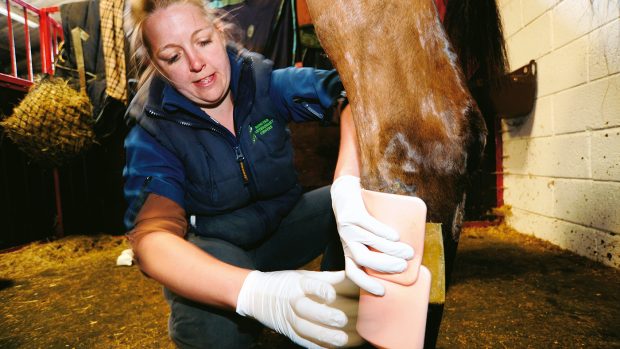A stable yard with dust particles from bedding and hay floating around, plus spray from fly repellents and coat conditioners and perhaps wood preservatives, can be a potentially hazardous place for our eyes.
When using anything that may present a risk, it is always advisable to wear protective eye goggles. Even the most superficial of grazes to the cornea (surface of the eye) may result in scaring or infection that can lead to permanently impaired vision, so treat all eye injuries with care — they present a potentially serious risk to the casualty’s sight.
The best way to remove most minor irritations floating on the white of the eye, such as dust and eyelashes, is by gently rinsing the eye out. Locate the problem by sitting the casualty down facing the light, then, standing behind them, gently separate the eyelids and carefully search the eye, asking the casualty to look left, right, up and down.
When the foreign body is located, wash it out with sterile eyewash or by pouring clean water from a glass. If you are unsuccessful, lift the object with a damp tissue or swab, or seek medical help.
Never touch anything that sticks to the eye, is on the coloured iris, the pupil or which has penetrated the eye. In these circumstances, the casualty should lie on his back holding a sterile dressing or clean, non-fluffy pad over the injured eye, while keeping both eyes as still as possible. Do not remove contact lenses and transport the person to hospital urgently.
If the eye is splashed with a chemical, it is vital to rinse it off immediately. This will dilute and disperse the chemical, minimising the potential damage to the surface of the eye. If possible wear disposable gloves and take care that the contaminated water doesn’t splash on to you or the casualty, overflow in to the other eye or run down the side of the face.
Hold the casualty’s eye under gently running cold water, either from a tap or by pouring water from a glass, until you are sure the chemical is gone. If pain causes the casualty to shut the eye, pull the eyelids open gently but firmly and irrigate carefully.
Give the casualty a sterile eye dressing or clean pad to hold over the injured eye while medical help is sought.
|
||
 |
||


 Get up to 19 issues FREE
Get up to 19 issues FREE TO SUBSCRIBE
TO SUBSCRIBE 


